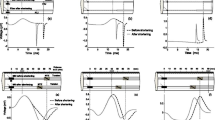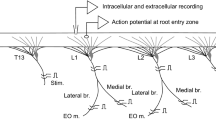Summary
-
1.
A set of 10 superficial fibers is described for the closer muscle of the crabEriphia spinifrons. The fibers are found in identical positions from one preparation to the next.
-
2.
According to innervation pattern and neuromuscular responses, the identified fibers can be classified in 4 major groups (I to IV). They are representative for the remaining fibers comprising the closer muscle.
-
3.
All muscle fibers of the closer are innervated by the fast excitor. Only the fibers also innervated by the slow excitor are further innervated by the common inhibitor (CI). CI innervation seems to be linked to the distribution of the slow axon.
-
4.
CI is most effective in fibers 2, 3 and 4 (group I fibers) through post- and mainly presynaptic mechanisms. Presynaptic inhibition drastically reduces excitatory transmission at the terminals of both the slow and the fast axon. Fiber 5 (group II fibers) receive(s) only postsynaptic inhibition.
-
5.
The strength of presynaptic inhibition varies at different junctions along a given muscle fiber from about 20 to almost 100%.
-
6.
Excitatory and inhibitory nerve terminal potentials were recorded allowing determination of the time relationship for optimal presynaptic inhibition. Inhibition reaches its optimum when the action potential in the inhibitory ending precedes that in the excitatory terminal by 5 to 8 ms. Presynaptic inhibition shows a long persistance. Half maximal inhibition is present when action potentials in the inhibitory endings occur 18 to 30 ms before those in the excitatory endings.
-
7.
CI plays an important role in the division of labor among muscle fibers receiving identical excitatory input. Fibers of group I (tonic fibers) are selectively inhibited and prevented from participation in tension generation during walking of the crab. During locomotion mainly group II fibers are active. A very large proportion of muscle fibers (group III and IV) appears not to be activated during slow walking.
Similar content being viewed by others
Abbreviations
- CI :
-
common inhibitor
- FCE :
-
fast closer excitor
- SCE :
-
slow closer excitor
- ejp :
-
excitatory junction potential
- entp :
-
excitatory nerve terminal potential
- ijp :
-
inhibitory junction potential
- intp :
-
inhibitory nerve terminal potential
References
Atwood HL (1963) Differences in muscle fibre properties as a factor in ‘fast’ and ‘slow’ contraction inCarcinus. Comp Biochem Physiol 10:17–32
Atwood HL (1965) Excitation and inhibition in crab muscle fibres. Comp Biochem Physiol 16:409–426
Atwood HL (1973) Crustacean motor units. In: Stein RB et al. (eds) Control of posture and locomotion. Plenum Press, New York, pp 87–104
Atwood HL (1976) Organization and synaptic physiology of crustacean neuromuscular systems. Prog Neurobiol 7:219–391
Atwood HL, Dorai Raj BS (1964) Tension development and membrane responses in phasic and tonic muscle fibers of a crab. J Cell Comp Physiol 64:55–72
Atwood HL, Hoyle G (1965) A further study of the paradox phenomenon of crustacean muscle. J Physiol 181:225–234
Atwood HL, Parnas I (1968) Synaptic transmission in crustacean muscles with dual motor innervation. Comp Biochem Physiol 27:381–401
Atwood HL, Hoyle G, Smyth T (1965) Mechanical and electrical responses of single innervated crab muscle fibres. J Physiol 180:449–482
Atwood HL, Parnas I, Wiersma CAG (1967) Inhibition in crustacean phasic neuromuscular systems. Comp Biochem Physiol 20:163–177
Ballantyne D, Rathmayer W (1981) On the function of the common inhibitory neurone in the walking legs of the crab,Eriphia spinifrons. J Comp Physiol 143:111–122
Dudel J, Kuffler SW (1961) Presynaptic inhibition at the crayfish neuromuscular junction. J Physiol 155:543–562
Fatt P, Katz B (1963) The effect of inhibitory nerve impulses on crustacean muscle fibre. J Physiol 121:374–389
Fischer L, Florey E (1982) Postsynaptic potential and postsynaptic current in muscle fibres with large time constant. Epsp amplitude is independent of membrane resistance. Gen Pharmacol 13:477–484
Hoyle G (1967) Specificity of muscle. In: Wiersma CAG (ed) Invertebrate nervous systems. University Chicago Press, Chicago, pp 151–167
Hoyle G, Wiersma CAG (1958) Excitation at neuromuscular junctions in Crustacea. J Physiol 143:402–425
Lang F, Sutterlin A, Prosser CL (1970) Electrical and mechanical properties of the closer muscle of the Alaskan king crabParalithodes camtschatica. Comp Biochem Physiol 32:615–628
Rathmayer W, Florey E (1974) Presynaptic inhibition of long duration at crab neuromuscular junctions. Pflügers Arch 347:77–81
Wiens TJ, Atwood HL (1975) Dual inhibitory control in crab leg muscles. J Comp Physiol 99:211–230
Wiersma CAG, Ripley SH (1952) Innervation patterns of crustacean limbs. Physiol Comp Oecol 2:391–405
Author information
Authors and Affiliations
Rights and permissions
About this article
Cite this article
Rathmayer, W., Erxleben, C. Identified muscle fibers in a crab. J. Comp. Physiol. 152, 411–420 (1983). https://doi.org/10.1007/BF00606246
Accepted:
Issue Date:
DOI: https://doi.org/10.1007/BF00606246




